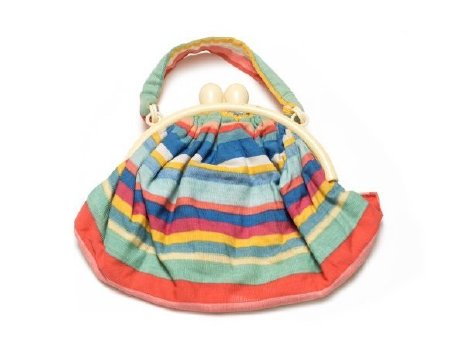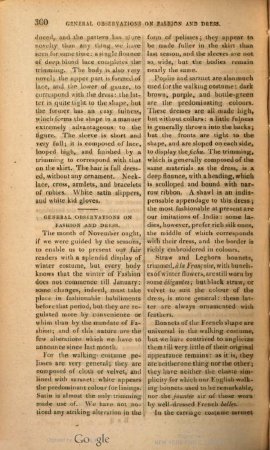Object ID:
2013.4.33
Label/Maker:
Ackermann, Rudolph
Date:
October 1, 1816
Object Details:
This Ackerman illustration depicts a lady in an evening dress that features the prevailing Vertical Epoque of the Regency period. With a high waisted, low-cut, and extensively trimmed bodice, evening attire could be made of a lightweight, striped fabric. To help induce modesty, the dress boasts delicate embellishments and elbow-length gloves. The addition of jewelry during this period looked to the past for inspiration from Classical Antiquity to Medieval and Renaissance modes. Here the short-puffed sleeves are highlighted by ruby colored beads that surround the upper arms. The matching choker necklace conveys a trend that began during the French Revolution, when women would wear red chokers as a political symbol expressing their disfavor of violence including execution by the guillotine.
Reference:
Cultural Connections:
With the mechanization of textile production, during the latter part of the 18th century, the development of patterns including stripes became stylish. Before striped textiles evolved, they were initially a sign of expulsion. French social historian Michel Pastoureau writes that, in the European Middle Ages, striped cloth took on strong connotations of deviance and abasement.23 However, as society moved toward the industrial era of the 19th century, this pattern took on new meaning. Here, the empire silhouette has further connotations of boldness and daringness, including a willingness to test the boundaries of social tolerance. Fast forward to 1917 when Coco Chanel launched jersey knit tops for women with horizontal stripes inspired by sailor uniforms and menswear. This modern style provided freedom for women who did not always want to dress in lace and frills. Striped textiles would also find fashionable positioning during the post WWII era. For example, in the late 1940s, stripes were commonly worn in a variety of color combinations including blue, red, brown, green, pink, and yellow for summer fashions. As the 1950s progressed, the striped shirt became a part of youth culture and was disseminated through television and film worn by actresses Audrey Hepburn and Brigette Bardot. Like the evening dress of the early 19th century, a modern vintage purse conveys a bold presence through prominently positioned stripes, which expressed societal conditions and fashion trends during the periods in which they were created.
Reference:
22 "1940s Handbags and Purses Fashion," Vintage Dancer, January 10, 2017. https://vintagedancer.com/1940s/1940s-handbags-purses-history/
23 "History of Famous Cloth Patterns: Stripes," Fashionologia Historiana, February 11, 2018. https://www.fashionologiahistoriana.com/costume-history-legends-essays-in-english/history-of-famous-cloth-patterns-stripes.
23 "History of Famous Cloth Patterns: Stripes," Fashionologia Historiana, February 11, 2018. https://www.fashionologiahistoriana.com/costume-history-legends-essays-in-english/history-of-famous-cloth-patterns-stripes.




